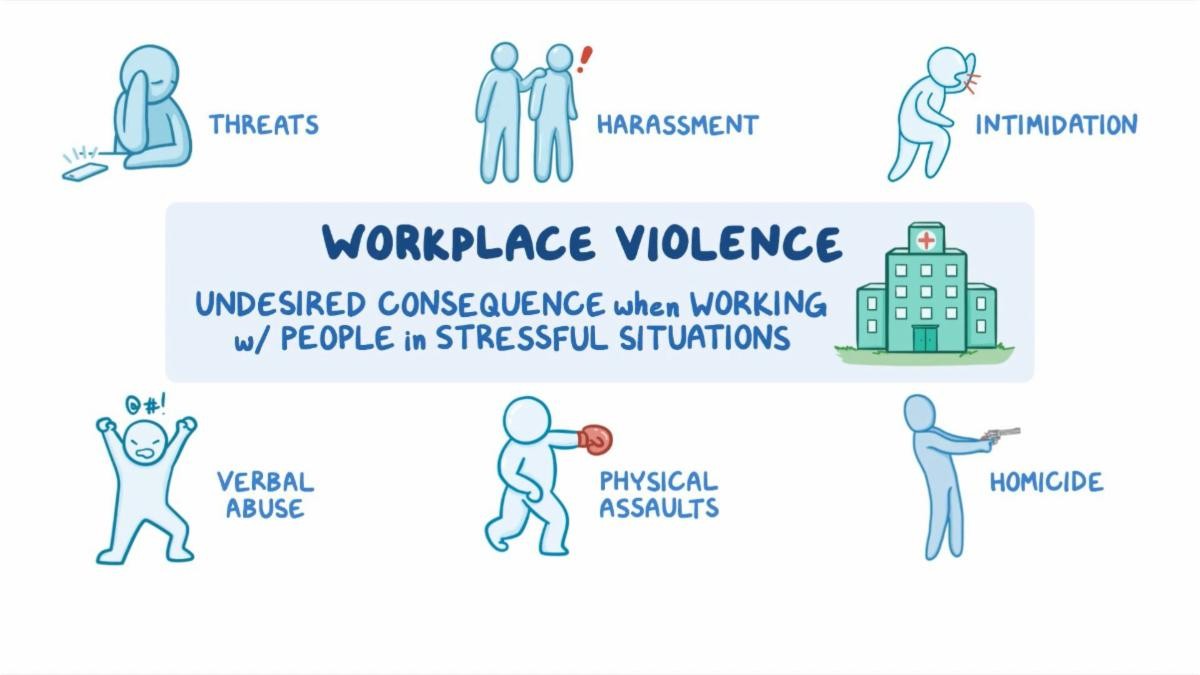The Duty of Training in California Workplace Violence Prevention: Key Insights
The Duty of Training in California Workplace Violence Prevention: Key Insights
Blog Article
The Role of Staff Member Training and Understanding in Enhancing Work Environment Physical Violence Avoidance Initiatives Throughout Different Industries
The assimilation of worker training and awareness right into workplace violence avoidance initiatives is increasingly acknowledged as an essential facet of organizational safety throughout diverse sectors. By applying targeted training programs, organizations can efficiently equip their labor force to identify and resolve potential threats prior to they intensify. Nonetheless, the efficiency of these efforts usually pivots on numerous essential aspects that differ by field, elevating essential inquiries regarding the flexibility of training techniques and their real-world effect. Comprehending these subtleties may expose techniques that can considerably boost safety and security procedures and staff member confidence in risky settings.
Relevance of Educating Programs
In today's dynamic work setting, the significance of training programs can not be overemphasized, particularly in the context of work environment violence prevention. These programs function as a foundational component in cultivating a safe and risk-free workplace society. By gearing up workers with the understanding and abilities essential to identify, reduce, and react to prospective threats, companies can promote an atmosphere that focuses on safety and health.
Effective training programs do more than merely instruct; they empower workers to recognize warning indications of violence, understand the procedures for reporting events, and develop strategies to de-escalate possible problems. Additionally, they instill a feeling of cumulative responsibility amongst staff, encouraging aggressive engagement in maintaining a safe office.
Financial investment in training not just improves employee recognition however additionally demonstrates an organization's dedication to guarding its workforce. This proactive technique can cause decreased cases of workplace violence, reduced absence, and improved employee spirits. Inevitably, thorough training programs are indispensable to establishing a durable business culture that values safety and security and promotes a healthy workplace, thereby minimizing the threat of violence and its associated consequences.
Secret Elements of Effective Awareness
An extensive recognition program incorporates a number of essential components that are essential for efficiently protecting against work environment violence. Initially, clear communication of policies and treatments related to work environment violence is vital. Workers must be informed concerning the company's stance on violence and the specific methods in area for reporting occurrences.
2nd, training sessions must incorporate sensible circumstances that staff members might run into. This functional strategy aids workers recognize advising signs of prospective physical violence and outfits them with the required skills to de-escalate stressful scenarios. Third, fostering an encouraging office society is important; staff members ought to really feel encouraged to talk up without fear of retaliation.
In addition, recurring education and learning is essential to keep awareness fresh and pertinent. Routine refresher training courses and updates on arising hazards can boost staff members' alertness and preparedness. Incorporating comments devices permits workers to share their experiences and insights, which can lead to continual enhancement of recognition initiatives. By integrating these parts, companies can create a durable structure for stopping workplace physical violence, inevitably contributing to a more secure and much more efficient atmosphere for all staff members.
Industry-Specific Training Techniques
Reliable workplace violence avoidance training need to be tailored to the unique challenges and threats dealt with by certain sectors. Health care atmospheres require training that attends to the high probability of experiences with hostile individuals or site visitors. Programs should focus on de-escalation techniques, acknowledging indication of potential violence, and guaranteeing staff understand the value of reporting incidents.
On the other hand, retail settings might deal with various threats, such as break-in or client conflicts. Training in these settings ought to emphasize situational understanding, feedback protocols throughout emergencies, and the value of securing money and belongings.
Manufacturing and building and construction markets provide their own threats, typically connected with social disputes or risky working conditions. Training in these industries must consist of methods for conflict resolution, advertising a culture of safety and security, and motivating open interaction among employees.
Additionally, company workplaces may need training focused on protecting against harassment and bullying, promoting a respectful office society, and carrying out clear coverage devices. Each sector must not just acknowledge its particular susceptabilities yet additionally adjust training products to reverberate with the workforce effectively, making sure that staff members feel complete and encouraged to handle prospective violent situations.
Measuring Training Performance
Reviewing the influence of office violence prevention training is vital for making certain that staff members are effectively prepared to handle possible threats. To properly determine training performance, companies need to implement both qualitative and measurable analysis techniques. Pre- and post-training surveys can determine modifications in employee knowledge, attitudes, and actions worrying workplace violence. These surveys must concentrate on particular training purposes to make certain alignment with the company's goals.
In addition, useful assessments, such as role-playing scenarios or simulations, can supply understandings right into exactly how well staff members apply learned abilities in real-life scenarios. Monitoring event reports before and after training can likewise work as an indicator of effectiveness, as a reduction in cases may reflect better staff member preparedness.
Additionally, feedback from participants should be systematically gathered to identify areas for enhancement in training web content and delivery. Conducting follow-up assessments at regular intervals assists suffer recognition and strengthens training concepts gradually - california workplace violence prevention. By employing a comprehensive approach to measuring training efficiency, organizations can make certain that their office violence prevention efforts promote a safer atmosphere and boost total worker well-being
Building a Culture of Safety And Security

Educating plays a crucial function in this cultural shift. Regular, detailed training sessions educate staff members concerning acknowledging indication of workplace violence and the ideal reactions. Urging open communication permits employees to voice concerns without fear of retribution, advertising collective responsibility for safety look at this website and security.
Additionally, integrating safety right into daily procedures makes sure that it comes to be a shared worth as opposed to a simple compliance problem. This includes normal safety and security drills, updates on policies, and feedback systems that include employees in safety discussions and enhancements.
Ultimately, a durable culture of safety not just reduces the risks of work environment violence but also enhances staff member morale and efficiency. By promoting an atmosphere where safety and security is a basic priority, organizations can produce resilient work environments that support both individual well-being and cumulative success.
Verdict
In conclusion, employee training and understanding are vital parts in the prevention of workplace violence throughout different sectors. Efficient training programs, tailored to details industry needs, improve staff members' capability to identify and respond to potential hazards. By executing extensive recognition techniques and cultivating a society of safety, companies site link can considerably decrease cases of workplace physical violence and enhance general employee morale. Commitment to continuous training and assessment makes certain sustained performance and flexibility in resolving emerging obstacles within the workplace setting.

Normal, comprehensive training sessions educate employees concerning acknowledging caution indications of workplace violence and the suitable responses.In final thought, worker training and awareness are crucial parts in the prevention of office physical violence across numerous markets.
Report this page